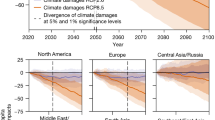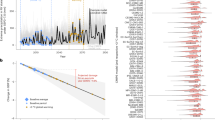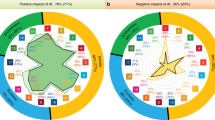Abstract
High-profile modelling studies often project that large-scale win–win solutions are widely available, but practitioners are often sceptical of win–win narratives, due to real-world complexity. Here we bridge this divide by showing mathematically why complexity makes win–wins elusive. We provide a general proof that increasing the number of objectives, the number of stakeholders or the number of constraints decreases the availability of win–win outcomes (here meaning Pareto improvements). We also show that a measure of tradeoff severity increases in the number of objectives. As the number of objectives approaches infinity, we show that this tradeoff severity measure approaches a limit unaffected by the curvature of the tradeoff surface. This is surprising because concave tradeoff-surface curvature results in less severe tradeoffs with fewer objectives. Our theory suggests that this difference gradually dissipates as objectives are added. In a meta-analysis, we show that 77% of empirically estimated two-objective tradeoff surfaces are concave. We then show how to approximately extrapolate our tradeoff severity measure to higher numbers of objectives, starting from estimated tradeoffs between fewer objectives. Our results provide modellers with precise intuition into practitioners’ scepticism of win–win narratives and practitioners with guidance for assessing the implications of simple tradeoff models.
This is a preview of subscription content, access via your institution
Access options
Access Nature and 54 other Nature Portfolio journals
Get Nature+, our best-value online-access subscription
$29.99 / 30 days
cancel any time
Subscribe to this journal
Receive 12 digital issues and online access to articles
$119.00 per year
only $9.92 per issue
Buy this article
- Purchase on Springer Link
- Instant access to full article PDF
Prices may be subject to local taxes which are calculated during checkout



Similar content being viewed by others
Data availability
All data used in this study are available in Supplementary Data 1.
References
Nelson, E. et al. Modeling multiple ecosystem services, biodiversity conservation, commodity production, and tradeoffs at landscape scales. Front. Ecol. Environ. 7, 4–11 (2009).
Tilman, D., Balzer, C., Hill, J. & Befort, B. L. Global food demand and the sustainable intensification of agriculture. Proc. Natl Acad. Sci. USA 108, 20260–20264 (2011).
Mueller, N. D. et al. A tradeoff frontier for global nitrogen use and cereal production. Environ. Res. Lett. 9, 054002 (2014).
Costello, C. et al. Global fishery prospects under contrasting management regimes. Proc. Natl Acad. Sci. USA 113, 5125–5129 (2016).
Burgess, M. G. et al. Protecting marine mammals, turtles, and birds by rebuilding global fisheries. Science 359, 1255–1258 (2018).
Pascual, U. et al. Social equity matters in payments for ecosystem services. Bioscience 64, 1027–1036 (2014).
Muradian, R. et al. Payments for ecosystem services and the fatal attraction of win–win solutions. Conserv. Lett. 6, 274–279 (2013).
Hopkins, S. R. et al. How to identify win-win interventions that benefit human health and conservation. Nat. Sustain. 4, 298–304 (2021).
Birkenbach, A. M., Smith, M. D. & Stefanski, S. Feature—taking stock of catch shares: lessons from the past and directions for the future. Rev. Environ. Econ. Policy 13, 130–139 (2019).
Perfecto, I. & Vandermeer, J. The agroecological matrix as alternative to the land-sparing/agriculture intensification model. Proc. Natl Acad. Sci. USA 107, 5786–5791 (2010).
Howe, C., Suich, H., Vira, B. & Mace, G. M. Creating win–wins from trade-offs? Ecosystem services for human well-being: a meta-analysis of ecosystem service trade-offs and synergies in the real world. Glob. Environ. Change 28, 263–275 (2014).
Hajjar, R. et al. A global analysis of the social and environmental outcomes of community forests. Nat. Sustain. 4, 216–224 (2021).
Tallis, H., Kareiva, P., Marvier, M. & Chang, A. An ecosystem services framework to support both practical conservation and economic development. Proc. Natl Acad. Sci. USA 105, 9457–9464 (2008).
O’Connell, C. S. et al. Balancing tradeoffs: reconciling multiple environmental goals when ecosystem services vary regionally. Environ. Res. Lett. 13, 064008 (2018).
Lester, S. E. et al. Marine spatial planning makes room for offshore aquaculture in crowded coastal waters. Nat. Commun. 9, 945 (2018).
Fukuyama, F. Political Order and Political Decay: From the Industrial Revolution to the Globalization of Democracy (Macmillan, 2014).
Coello, C. A. C., Lamont, G. B. & Van Veldhuizen, D. A. Evolutionary Algorithms for Solving Multi-Objective Problems 2nd edn (Springer, 2007).
Lester, S. E. et al. Evaluating tradeoffs among ecosystem services to inform marine spatial planning. Mar. Policy 38, 80–89 (2013).
Hegwood, M., Langendorf, R. E. & Burgess, M. G. Supplementary video for Hegwood, Langendorf, and Burgess tradeoff analysis. Zenodo https://doi.org/10.5281/zenodo.6087610 (2022).
Plaza‐Úbeda, J. A., Burgos‐Jiménez, J., Vazquez, D. A. & Liston‐Heyes, C. The ‘win–win’ paradigm and stakeholder integration. Bus. Strategy Environ. 18, 487–499 (2009).
Polasky, S. et al. Where to put things? Spatial land management to sustain biodiversity and economic returns. Biol. Conserv. 141, 1505–1524 (2008).
Halpern, B. S. et al. Achieving the triple bottom line in the face of inherent trade-offs among social equity, economic return, and conservation. Proc. Natl Acad. Sci. USA 110, 6229–6234 (2013).
White, C., Halpern, B. S. & Kappel, C. V. Ecosystem service tradeoff analysis reveals the value of marine spatial planning for multiple ocean uses. Proc. Natl Acad. Sci. USA 109, 4696–4701 (2012).
Groot, J. C. et al. Exploring multi-scale trade-offs between nature conservation, agricultural profits and landscape quality—a methodology to support discussions on land-use perspectives. Agric. Ecosyst. Environ. 120, 58–69 (2007).
Groot, J. C., Jellema, A. & Rossing, W. A. Designing a hedgerow network in a multifunctional agricultural landscape: balancing trade-offs among ecological quality, landscape character and implementation costs. Eur. J. Agron. 32, 112–119 (2010).
Law, E. A. et al. Fading opportunities for mitigating agriculture–environment trade-offs in a South American deforestation hotspot. Biol. Conserv. 262, 109310 (2021).
Rabotyagov, S. et al. Spatial multiobjective optimization of agricultural conservation practices using a SWAT model and an evolutionary algorithm. J. Vis. Exp. 70, 4009 (2012).
Ruijs, A., Wossink, A., Kortelainen, M., Alkemade, R. & Schulp, C. J. E. Trade-off analysis of ecosystem services in Eastern Europe. Ecosyst. Serv. 4, 82–94 (2013).
Tóth, S. F. & McDill, M. E. Finding efficient harvest schedules under three conflicting objectives. For. Sci. 55, 117–131 (2009).
Zhou, Z. X., Li, J., Guo, Z. Z. & Li, T. Trade-offs between carbon, water, soil and food in Guanzhong–Tianshui economic region from remotely sensed data. Int. J. Appl. Earth Obs. Geoinf. 58, 145–156 (2017).
Yang, W. et al. Trade-offs among ecosystem services in coastal wetlands under the effects of reclamation activities. Ecol. Indic. 92, 354–366 (2018).
Lautenbach, S., Volk, M., Strauch, M., Whittaker, G. & Seppelt, R. Optimization-based trade-off analysis of biodiesel crop production for managing an agricultural catchment. Environ. Model. Softw. 48, 98–112 (2013).
Zhong, J. et al. Analysis of environmental and economic tradeoffs in switchgrass supply chains for biofuel production. Energy 107, 791–803 (2016).
Kanter, D. R. et al. Evaluating agricultural trade-offs in the age of sustainable development. Agric. Syst. 163, 73–88 (2018).
Bryan, B. A. et al. Land use efficiency: anticipating future demand for land‐sector greenhouse gas emissions abatement and managing trade‐offs with agriculture, water, and biodiversity. Glob. Change Biol. 21, 4098–4114 (2015).
Juutinen, A. et al. Trade-offs between economic returns, biodiversity, and ecosystem services in the selection of energy peat production sites. Ecosyst. Serv. 40, 101027 (2019).
Nalle, D. J., Montgomery, C. A., Arthur, J. L., Polasky, S. & Schumaker, N. H. Modeling joint production of wildlife and timber. J. Environ. Econ. Manage. 48, 997–1017 (2004).
Burgess, M. G., Clemence, M., McDermott, G. R., Costello, C. & Gaines, S. D. Five rules for pragmatic blue growth. Mar. Policy 87, 331–339 (2018).
Acknowledgements
We thank P. Newton, T. Ippolito, W. Eichhorst and R. Marshall for feedback on earlier drafts of the manuscript, and C. Brooks, B. Wallace, D. Dorman, C. Burgess, D. Kaffine and attendees of several seminars for helpful feedback on and discussion of the concepts and mathematics discussed here. M.H. and M.G.B. acknowledge funding from the US Department of Agriculture (USDA) and National Institute of Food and Agriculture (NIFA) (Award number: 2020-38420-30727 to M.G.B.). R.E.L. and M.G.B. acknowledge funding from the University of Colorado Boulder (start-up grant to M.G.B.).
Author information
Authors and Affiliations
Contributions
M.G.B. conceived the project, M.H. and R.E.L. assembled and analysed the data, and M.G.B., R.E.L. and M.H. completed the mathematical proofs. M.G.B., M.H. and R.E.L. wrote the paper.
Corresponding author
Ethics declarations
Competing interests
The authors declare no competing interests.
Peer review
Peer review information
Nature Sustainability thanks Rebecca Shaw, Alex Strang and the other, anonymous, reviewer(s) for their contribution to the peer review of this work.
Additional information
Publisher’s note Springer Nature remains neutral with regard to jurisdictional claims in published maps and institutional affiliations.
Supplementary information
Supplementary Information
Supplementary methods.
Supplementary Data 1
Full meta-analysis data.
Supplementary Data 2
Data input file for Mathematica code.
Supplementary Software 1
Mathematica code for Figs. 2d and 3c,d.
Rights and permissions
About this article
Cite this article
Hegwood, M., Langendorf, R.E. & Burgess, M.G. Why win–wins are rare in complex environmental management. Nat Sustain 5, 674–680 (2022). https://doi.org/10.1038/s41893-022-00866-z
Received:
Accepted:
Published:
Issue Date:
DOI: https://doi.org/10.1038/s41893-022-00866-z



